From traditional print media to websites and mobile apps, elements of graphic design are part of our everyday lives.
From giving instruction, conveying ideas and emotion, or simply presenting goods and services in the best way possible, graphic design is art, commerce, and visual communication all wrapped into one. In an increasingly visual world, the skills of graphic designers are in demand now more than ever.
Those who think it’s impossible to turn your natural creative abilities in color coordination, composition, and design into a career with a future have obviously never considered graphic design. Best of all, good wages are possible in the field of graphic design with relatively little formal education and a strong portfolio. For example, some talented individuals find work in graphic design after simply earning their associate degree.
If you’re looking for secure job prospects that will allow you to utilize your creativity, then the field of graphic design could be right for you. Find out more in Online Schools Report’s ultimate guide to careers and degrees in this exciting industry.
What Is Graphic Design?
Graphic designers work in advertising, marketing, communications, and the computer industry. They play a part in web design as well as app development. Graphic designers also create albums, book covers, flyers, posters, and other traditional print media. They work in the entertainment industry, especially the video game industry. Additionally, icons such as the ones that help you find your way through an environment like an airport is likely the work of a graphic designer. So, too, are many other forms of visual communication we rely on in our everyday lives.
What’s clear is that graphic design is an interdisciplinary branch of design with many useful applications. The job market is generally strong for graphic designers, and that shows no sign of slowing down anytime soon as the world becomes more and more dependent on imagery, marketing, and media. There are many different kinds of degrees available in graphic design, and given the digital nature of the field, it’s easy to complete a graphic design degree entirely online.
Roberta Morris graduated from Arkansas State University in 1994 with a degree in graphic design. She’s now the founder and creative director at Leave it to ‘Berta, a full-service branding agency. A graphic design degree, she says, formalized her education and systemically trained her in the methodology and practice of marketing, branding, and advertising.
“Graphic Design is truly an occupation that benefits from having a clear understanding of the history of design, as well as techniques and best practices,” she says.
Morris goes on to say her experience in college wasn’t just about classwork. It was also about the mentoring relationships she made with professors.
“One of my best mentors was a young professor named Debra Satterfield,” she continues. “She was really instrumental in showing me that women could be opinionated, strong, and could pursue what traditionally had been a male-dominated field—advertising,” Morris says.
Some who study graphic design go on to form their own companies, like Morris. Many more already existing and good-paying jobs are available, though, for talented graphic designers with a strong portfolio, and sometimes, nothing more than an associate degree. You may also be surprised how well a degree in graphic design also qualifies a graduate to work in tangential industries, as visual communication reaches every corner of society.
In this article, we cover just a few of the many great careers made possible by a degree in graphic design. We also provide an overview of degree paths in this field. The future is bright and colorful for graphic designers; be a part of it with this ultimate guide to graphic design.
Careers in Graphic Design
In addition to any one of the great careers listed below, a degree in graphic design opens the door for work in publishing, as a medical illustrator, or as a UX designer in software and web development. Keep reading to find out which one of these many exciting careers could be right for you.
| Job Title | Approx. # years of education | Average Annual Salary |
| Multimedia Artist and Animator | 4 | $75,270 |
| Graphic Designers | 4 | $52,110 |
| Web Developers and Digital Designers | 2 | $73,760 |
| Industrial Designers | 4 | $68,890 |
| Advertising, Promotions, and Marketing Managers | 4 | $135,900 |
All salary data is courtesy U.S. Bureau of Labor Statistics Occupational Outlook Handbook.
Multimedia Artist and Animator

Multimedia artists and animators can be found in every corner of the entertainment industry. They envision, design, and develop the two and three-dimensional images and graphics used in film, TV, video games, and on the internet, among other applications.
For these reasons, multimedia artists and animators rely heavily on computers to produce motion graphics and animation. Many work in teams with specialists in other aspects of game design, special effects, or video and film production. The creative process of a multimedia artist and animator sometimes begins with research as they take a deep dive into the real-world look, feel, and physical dynamic of whatever graphic or animation element they’re tasked with designing.
Part of the job of a multimedia artist and animator is to work closely with a director or producer, fine-tuning their creation until the process is complete. They might meet frequently with all interested parties to address workflow and deadlines related to projects. Multimedia artists also tend to specialize in special effects and computer-generated imagery, also known as CGI.
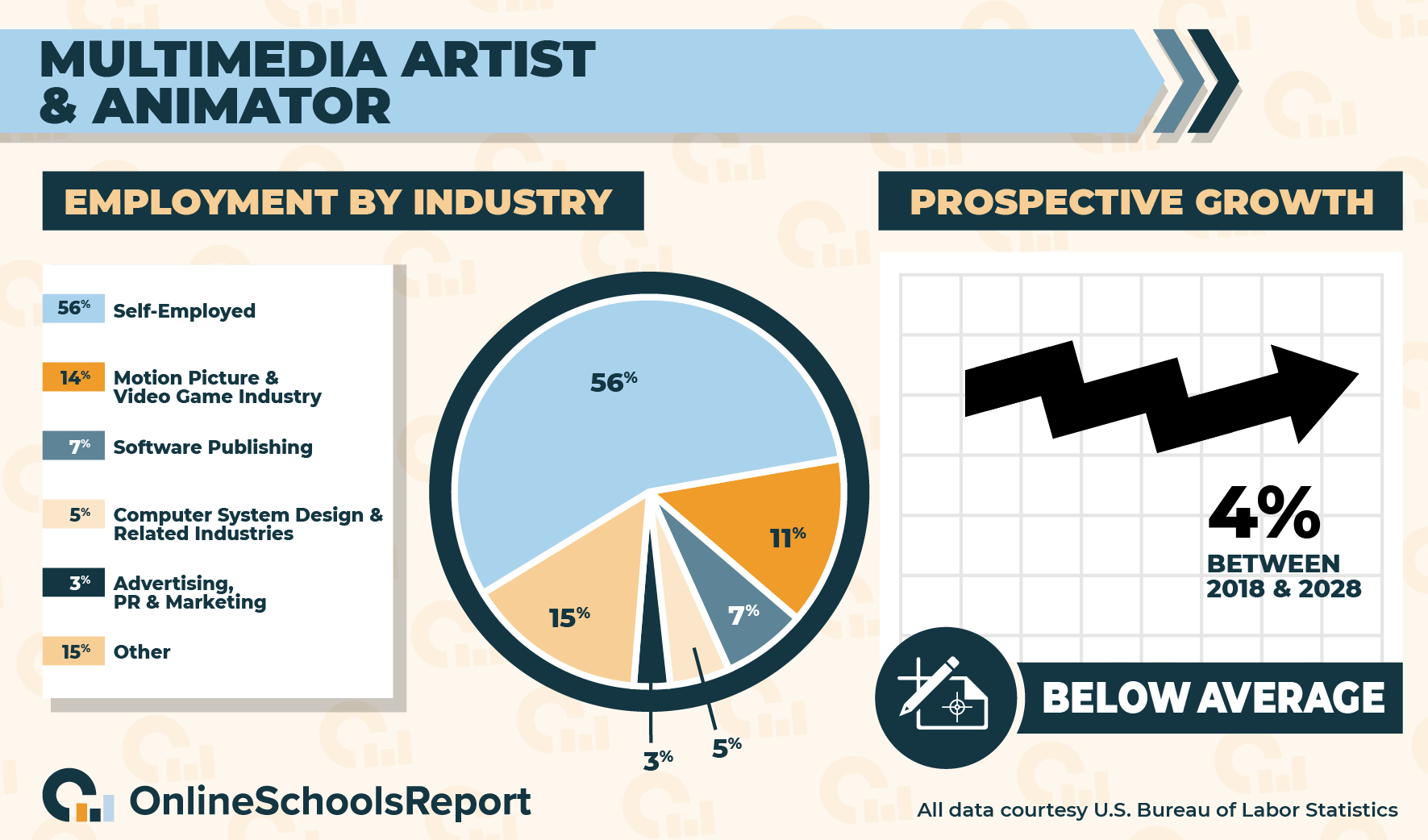
According to the Bureau of Labor Statistics, a bachelor’s degree is most often the minimum education requirement to find work as a multimedia artist and animator, though a combination of work experience, education, and a strong portfolio goes a long way in this industry. College degrees applicable to work in this field are usually art and design-related majors like graphic design.
Membership in a trade or professional association is rarely required as a condition of employment, though such organizations do exist. One such example is the Entertainment Software Association (ESA).
Also according to the BLS, the average starting salary for a multimedia artist and animator is a little more than $75,000 dollars a year, and there are a little less than 68,000 positions for multimedia artists and animators in the U.S. That number is expected to grow over the course of 2019-2029 by a rate of 4%, which is an average rate of growth when compared to many other professions.
Also according to data from the BLS, 56% of all multimedia artists and animators are self-employed. An additional 14% work in the motion picture and video game industry, 7% work in software publishing, and 5% work in computer system design and related industries. The final 3% of multimedia artists and animators work in advertising, public relations, and marketing.
If you live in California, New York, or Texas you have a good chance of finding work as a multimedia artist and animator.
Graphic Designers

One of the most common careers for anyone who majors in graphic design is, of course, that of a graphic designer. And although the Bureau of Labor Statistics estimates a slight decline of about 4% in terms of job outlook, there are still about 282,000 graphic design jobs in the US, so job prospects for graduates remain strong. There are also many different job titles in various organizations that require the skills, background, and training of a graphic designer.
In their work, graphic designers work closely and maintain valuable relationships with clients and art directors. Their objective is to use digital illustration, photo editing software, and layout software to accomplish the goal of the project and satisfy the needs of the client. This involves delivering logos, illustrations, and a variety of other kinds of imagery and visual communication. Graphic designers work with color, imagery, and typefaces among other design elements to present work to clients and art directors.
Graphic designers must also collaborate with clients and coworkers to incorporate changes and feedback to finalize the design before production. The work of a graphic designer touches everything from logos and promotion to public relations collateral and product packaging. Many designers specialize in just one of the many end-use applications of their work.
Otherwise, a bachelor’s degree or a combination of work experience, portfolio, and education is the barrier over which most graphic designers must cross to find work, according to the BLS.
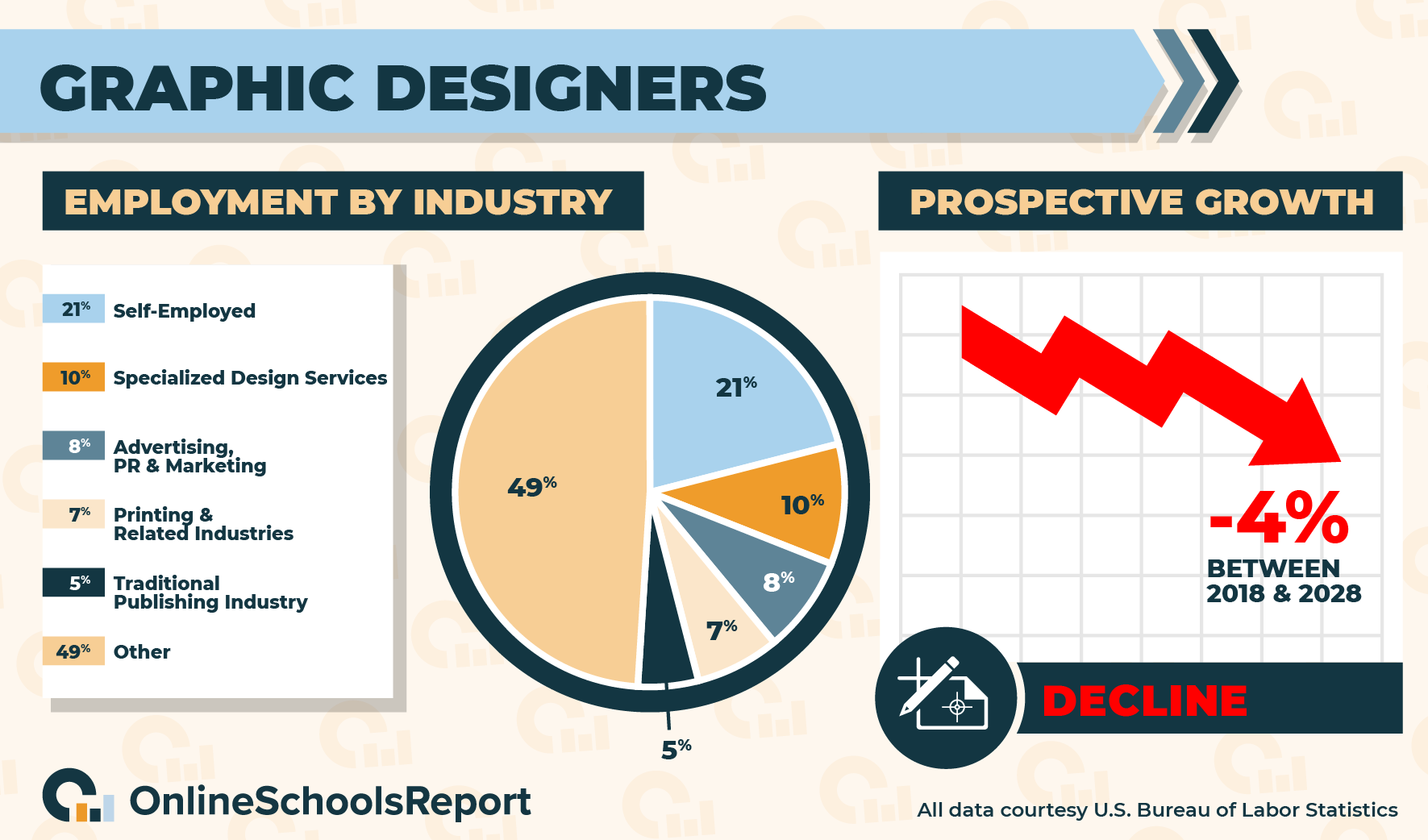
Also according to the BLS, graphic designers make about $52,000 dollars a year on average. Those interested in majoring in graphic design should pursue a degree through an institution accredited through the National Association of Schools of Art and Design (NASAD). An important professional association for graphic designers is the American Institute of Graphic Arts (AIGA).
BLS data also states that 21% of graphic designers are self-employed. Following that, 10% work in specialized design services, and 8% work in advertising, publishing relations, and related industries like marketing. Following that, 7% work in printing and related industries, while 5% work in the traditional publishing industry. States with strong employment numbers for graphic designers include California and New York.
Web Developers and Digital Designers

There are many similarities and some subtle differences between the work of a web developer and a graphic designer. Many who study graphic design go on to work in the field of development and digital design. Like graphic designers, web developers and digital designers work closely with clients, art directors, and project managers. In addition to design, they test interfaces, applications, navigation menus, and much more.
Unlike graphic designers, digital developers and designers often write code for websites using programming languages such as HTML and XML. Throughout the process, they maintain a close working relationship with other designers and graphic artists, as well as clients, project managers, and art directors. Through these collaborations, digital designers and web developers decide what elements a digital asset like a website must contain, such as graphics, video, and audio.
In their work, web developers and digital designers may also monitor website traffic and create mockups of websites and applications. There are also a few areas of specialty within the field, such as back-end web developers, who are charged with the technical aspects of a website. Some also specialize in front-end web development or the visual aspects of the site. There are also web and digital interface designers, drilling even further down into the user experience of a digital asset.
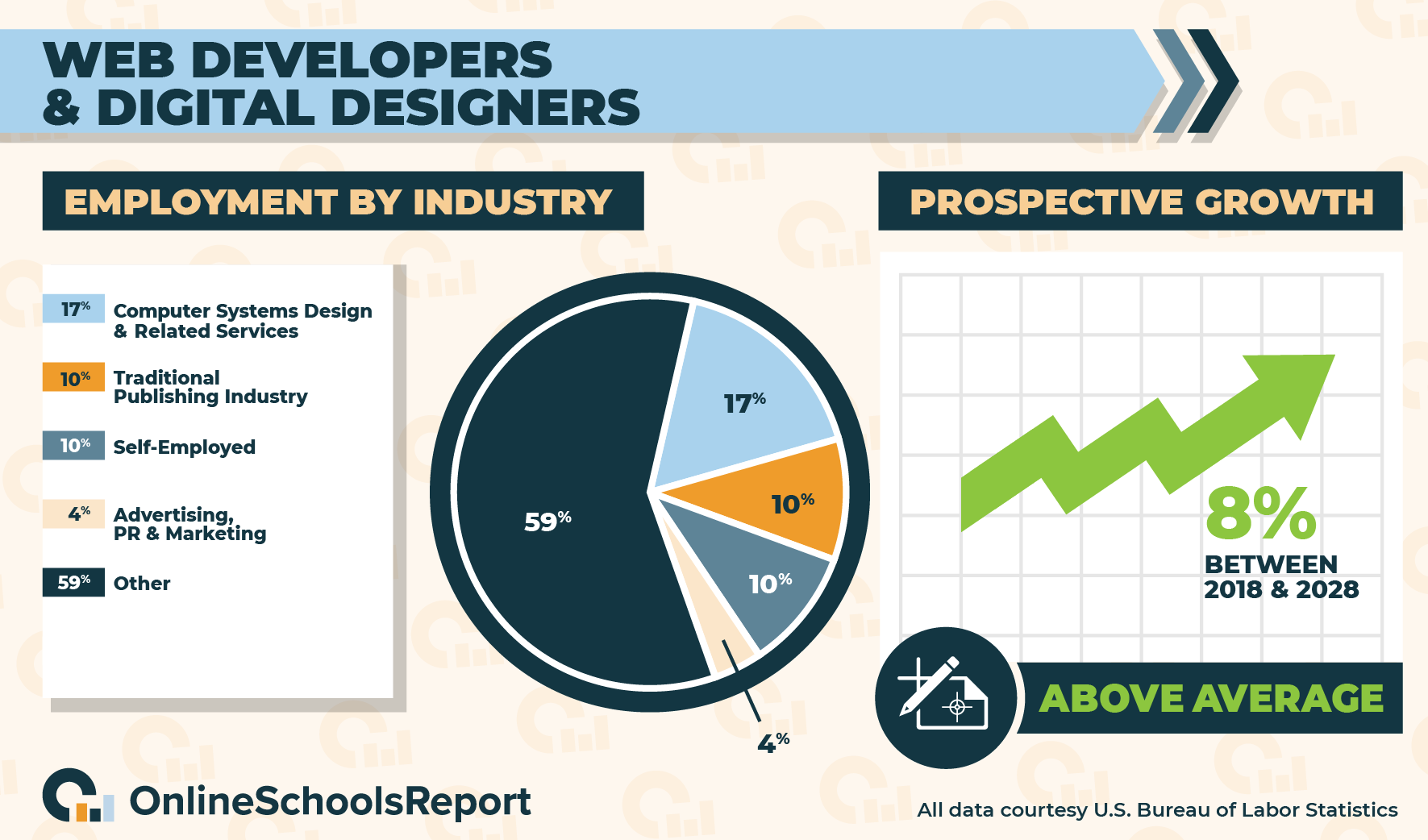
According to the Bureau of Labor Statistics, web developers and digital designers make about $74,000 dollars a year. What’s appealing to many about this profession is that an associate degree in a major like graphic design is the minimum education requirement for many employers. Nevertheless, many go on to complete advanced degrees in subjects like graphic design or computer science.
Data from the BLS also states there are about 174,000 jobs for web developers and digital designers in the US. This number is estimated by the BLS to grow at a rate of about 8% in the decade spanning 2019–2029, which is much faster than the average rate of growth in other professions.
Also according to the BLS, 17% of web developers and digital designers work in computer systems design and related services while 10% work in the traditional publishing industry. Following that, 10% are self-employed and 4% are employed in advertising, public relations, and related industries like marketing. States with strong employment numbers in this industry include California and Washington.
Industrial Designers

Industrial design is another common career path for those with an educational background in graphic design. Mixing art, business, and engineering, industrial designers work closely with clients to design a broad range of manufactured products. Part of this process is to thoroughly research all the ways a specific product might be used as well as the needs of those who might use it.
Industrial designers then sketch renderings of the product or develop digital examples of their design concept. Following that, digital models of the product are then created, and then possibly prototypes. Researching and sourcing materials related to the production of the product may also be under the purview of an industrial designer.
Industrial designers must often work closely with engineers and manufacturers to ensure production costs are reasonable, as well as to evaluate the safety, appearance, and functionality of a particular product. Lastly, industrial designers and their team will present their designs and concepts to clients, project managers, and other interested parties.
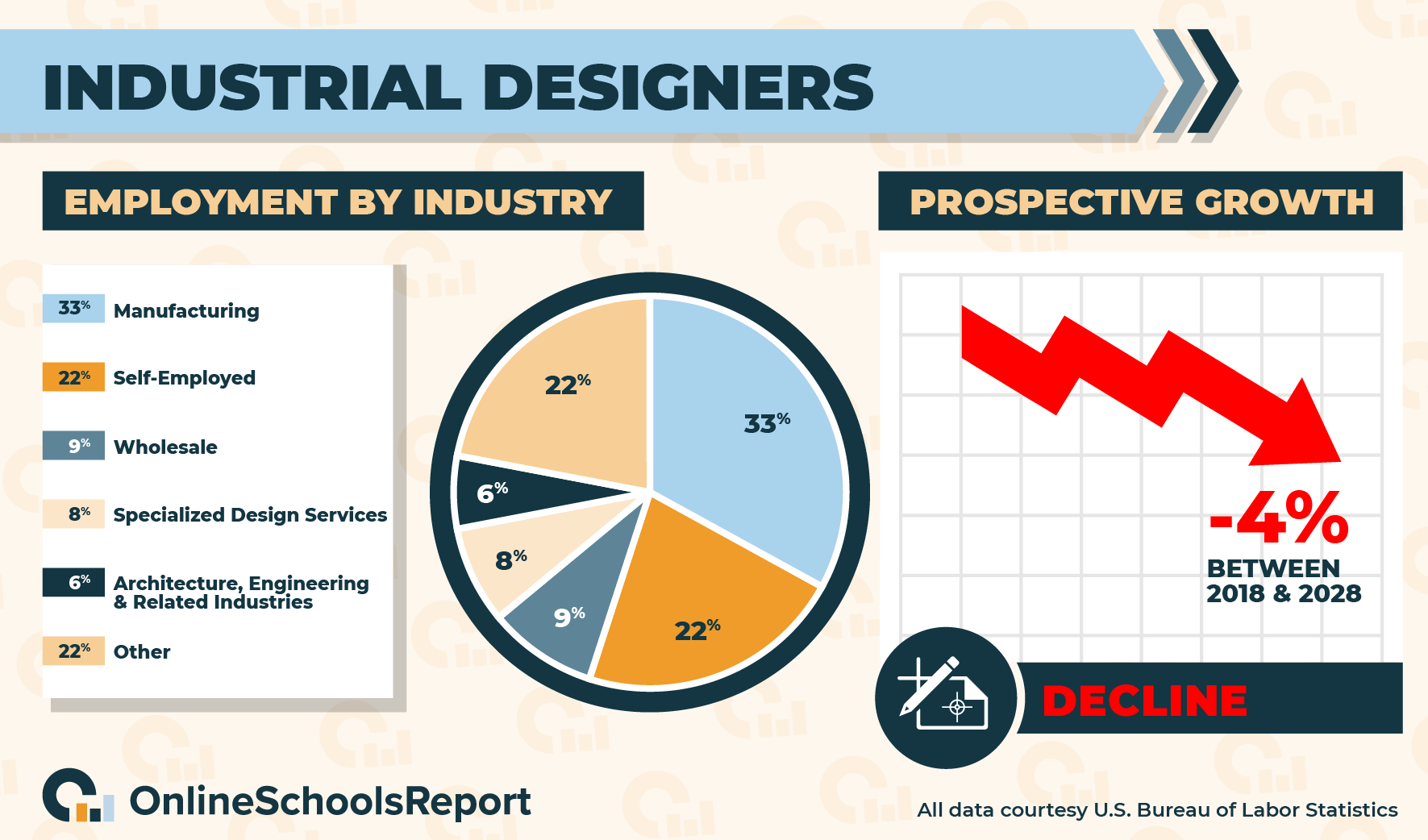
According to the Bureau of Labor Statistics, a bachelor’s degree in a design-related major, architecture, or engineering is most often the minimum educational requirement to find work as an industrial designer. Those who study graphic design in college may need to supplement their education with an advanced degree in an engineering field, or in subjects like drawing, computer-aided design and drafting (CADD), and three-dimensional modeling. Courses in industrial materials and processes, business, and manufacturing are also useful. It’s important that anyone interested in becoming an industrial engineer attend an institution accredited by the National Association of Schools of Art and Design.
Also according to the BLS, there are about 42,000 industrial design jobs in the U.S. Unfortunately, that number is expected to decline at a rate of 4% in the decade between 2019–2029. For this reason, industrial design can be seen as a tough job market.
BLS data also states that 33% of industrial designers work in manufacturing while 22% are self-employed. Following that, 9% work in wholesale and 8% find work in specialized design services. The remaining 6% of industrial designers work in architecture, engineering, and related industries.
Important trade organizations for industrial designers include the Industrial Designers Society of America (IDSA) and the World Design Organization (WDO), among many others. Good states to live in if you’re an industrial designer include Michigan and California.
Advertising, Promotions, and Marketing Managers

The general advertising, marketing, promotions, and public relations industries rely heavily on visual communication. That means a graphic designer is uniquely qualified to advance in this industry to the level of a manager.
Advertising, promotions, and marketing managers are in charge of budgets, contracts, marketing plans, and other elements of advertising media. They may also plan promotional campaigns such as contests, coupons, and giveaways, as well as plan advertising campaigns through various forms of media.
Part of this process is to negotiate advertising contracts with clients and media outlets while also evaluating the overall aesthetic of websites, ad campaigns, layouts, and other forms of marketing collateral. The pricing structure can also be included in the planning of an advertising strategy. Advertising, promotions, and marketing managers may also launch research studies to determine the effectiveness of an advertising campaign. They meet regularly with clients and superiors to report their results, and may even direct the hiring and supervision of staff to support the process.
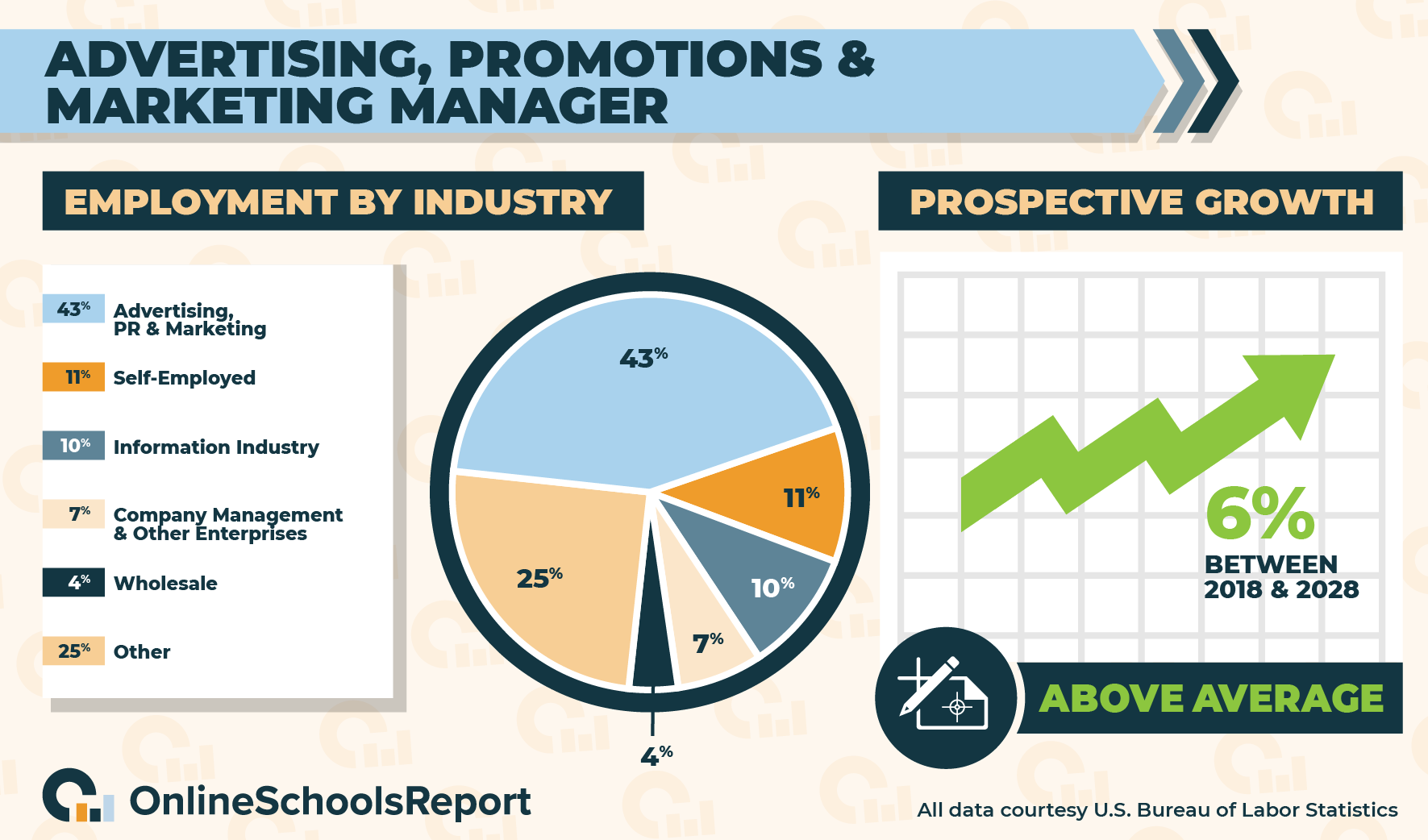
According to the Bureau of Labor Statistics, a bachelor’s degree is the minimum educational requirement to work as an advertising, promotions, and marketing manager. In addition to advertising and marketing, related degrees can include computer science, business, or an art and design-related major like graphic design. Notable trade organizations in the field include the American Advertising Federation and the World Federation of Advertising, among many others.
Also according to the BLS, managers in this industry make about $136,000 dollars a year on average, and there are about 315,000 jobs in the U.S. That number is projected to increase at a clip of 6% from 2019–2029, which is faster than average.
Perhaps unsurprisingly, the BLS also states that 43% of those employed in this profession work in advertising, public relations, and marketing. An additional 11% are self-employed, 10% work in the information industry, and 7% manage companies and other enterprises. The remaining 4% work in wholesale. Good states to live for advertising, promotions, and marketing managers include California, Illinois, and New York, according to the BLS.
Graphic Design Degrees
Ready to get your start in graphic design? Consider one, or all, of the exciting degree choices listed below and you’ll be well on your way to starting your dream career.
Associate Degree in Graphic Design

An Associate of Art (AA) Degree in Graphic Design in tandem with a strong portfolio is perhaps the fastest and most affordable way for a graphic designer to enter the workforce. These two-year degrees offered online and in the traditional classroom setting ground students in visual communication, basic composition, and the history and business of graphic design. Areas of emphasis can include typography, web design, and much more. Students also gain proficiency using software like Dreamweaver and Adobe InDesign.
Whether the AA program is online or in-person, it’s important that it’s accredited. An Associate of Art (AA) degree in Graphic Design will provide students with a broad range of credits both in graphic design and education. Those credits can be transferred to a four-year college or university to complete a bachelor’s degree in graphic design or a related major.
Associate of Applied Science (AAS) in Graphic Design degrees, on the other hand, are more vocationally focused and non-transferable. For this reason, an AAS degree is a better choice for anyone seeking to find work as quickly as possible. Professional certifications in software such as Adobe Illustrator and Dreamweaver are also commonly available and can further improve employment opportunities. Given the digital nature of the modern graphic design industry, this major is particularly well-suited to the online classroom environment.
Sample coursework in an AA or AAS program in graphic design can include fundamentals of drawing, digital photography, and web design, among many other subjects. A high school diploma with transcripts and a GPA of at least 2.0 is most often required to apply to an associate degree program in graphic design, though application requirements vary between programs. SAT and ACT scores may also be required.
Associate degrees typically consist of about 60 credit hours, which takes most students about two years to complete, though this can vary. Many students balance work and family life while completing an associate degree program, and most programs are designed to work around these schedules.
Bachelor’s Degree in Graphic Design

Moving on from an associate degree, a bachelor’s degree is the next step in the education of a graphic designer. Bachelor’s degree programs can be entered directly after finishing high school or can be transferred to upon completion of an associate degree.
The curriculum in a Bachelor of Arts in Graphic Design will move away from the vocational nature of an AA or AAS program and toward a more theoretical approach to the subject matter. Nevertheless, any graduate with a BA in Graphic Design will be well prepared for typical entry-level work in the industry, with the potential to advance to positions of management and art direction. While researching schools, it’s important to ensure that your program is accredited and recognized by the National Association of Schools of Art and Design.
With a heavy emphasis on multimedia design, many graphic design programs are offered in-person, entirely online, or in a hybrid model. Typical coursework in a Bachelor of Arts in Graphic Design covers subjects such as basic design and color theory, digital graphic design for the web, and print media layout and design. Graduates will also gain mastery in common industry software such as Adobe Photoshop and Illustrator.
Areas of emphasis, concentration, or specialty can range from 3D modeling and animation to logo design and sustainable design. Graduating with a BA in graphic design also qualifies a student to continue on to an advanced degree, such as a Master of Art (MA) in Graphic Design or in a related subject matter. A high school diploma or a transfer degree like an AA in Graphic design is required to apply for any bachelor’s degree program, as are transcripts with a GPA of at least 2.0. Application requirements vary between programs. Letters of recommendation or a statement of personal intent may also be required.
Bachelor’s degree programs typically require 120 credits to complete, which includes a combination of general education and graphic design coursework. A final project is also often required as a condition to graduate. This takes many students approximately four years to accomplish, though this too can vary. Many students save money and time completing the first two years of their program through an associate degree.
Master’s Degree in Graphic Design

Progressing further into the theoretical study of graphic design, a Master of Art (MA) is the next degree option in the major. Although few employers outside of academia require a Master of Arts in Graphic Design as a condition of employment, earning the degree can still be worth it. It qualifies a graduate to teach at the college or university level and may also provide a competitive advantage in terms of career advancement opportunities.
Master’s degree programs also allow students to further concentrate on specific areas of interest, such as motion graphics, mixed and web media design, and publication design. A BA in Graphic Design or a related major with transcripts and a GPA of at least 2.5 is required to apply for an MA program. Additional test scores may also be required, as can work experience in the industry, letters of recommendation, or a statement of personal intent.
A terminal thesis or project, developed in conjunction with a faculty advisor, is typically required to graduate. Generally speaking, master’s degree programs consist of about 60 credit hours, which takes most students about two years to complete, though some take longer depending on the nature of the program. It’s possible to earn an MA in Graphic Design through traditional coursework, completely online, or a combination of both.
An MA in Graphic Design also qualifies a graduate to gain additional professional credentials, such as Animation and Motion Media Certification, a Business Communication Certificate, or certification as a Mobile App Specialist, among many others.
Doctorate’s Degree in Graphic Design

Though rare, it is possible to earn a Ph.D. in graphic design. Students pursuing a Ph.D. in graphic design are typically interested in teaching at the university level, though some graduates do go on to research and develop graphic design technology, typography, or advances in the overall industry of graphic design.
Otherwise, a Ph.D. is almost never required in a job application in graphic design, though earning the degree could certainly provide a competitive advantage for a job candidate. In a Ph.D. program in graphic design, students may learn interactive design, web design, and advanced typography, among other subject matter. A graduate will also be well-versed in qualitative and quantitative research methods, design theory, and criticism.
Ph.D. programs are typically research-heavy, and there is usually a dissertation or terminal project required to graduate. Additional courses may cover topics like multicultural history and design history, among many others. A master’s degree is usually required to apply to any Ph.D. program, with transcripts and a GPA of 3.0. Additional test scores such as the GRE may also be required, as well as letters of recommendation or a statement of personal intent.
Ph.D. programs typically consist of about 120 credit hours, which takes many students about two years to complete, though developing and defending a dissertation can take longer. Ph.D. programs are offered online, in the classroom or workshop setting, or through a hybrid model. Most are designed to work around the schedule of working professionals, and many Ph.D. students also teach at the institution from which they are earning their degree.





